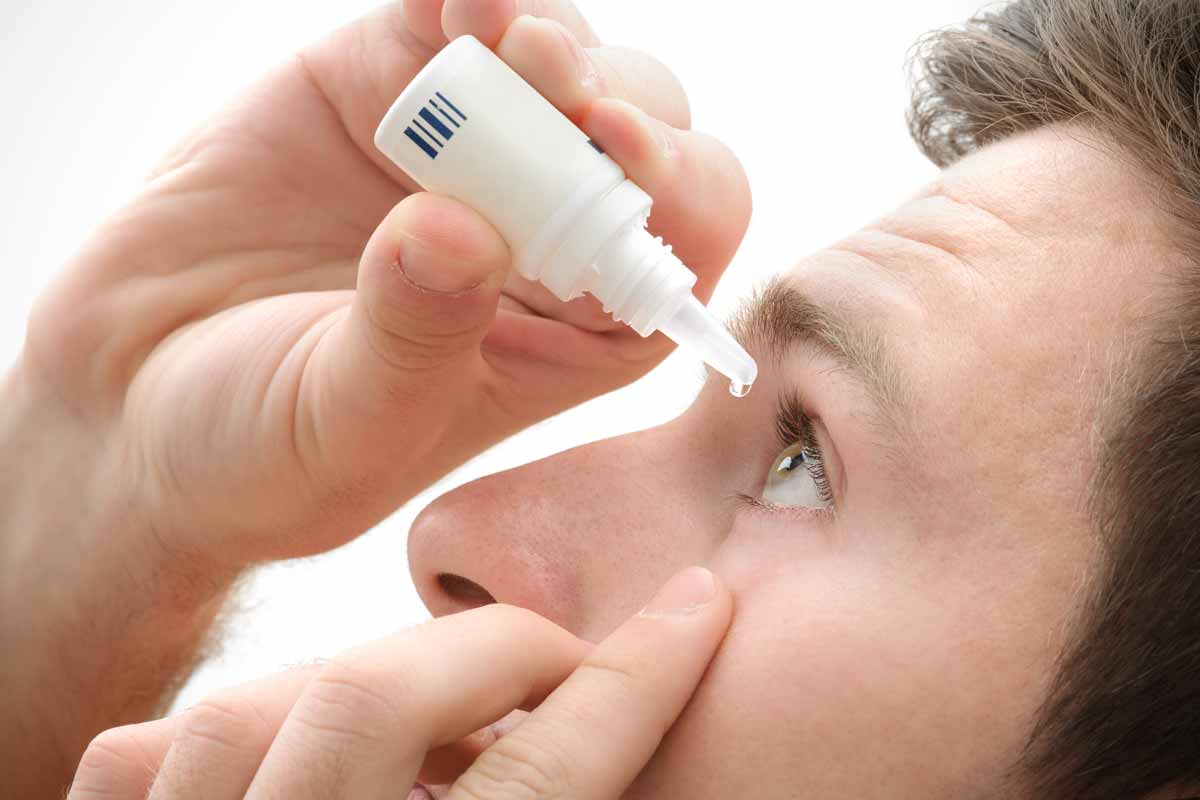How To Put On Eye Makeup After Cataract Surgery
After cataract surgery, your doctor will provide a listing of instructions to follow to help you heal. Many of the bullet points on that list will business organization eye drops. The best drops to use after cataract surgery are those listed on your take-home instructions.
Your medico is likely to give you prescription center drops, including some that reduce inflammation and others that combat infection.
Your medico may give you some leeway in eye drops designed to soothe redness and itching. In full general, you should cull products that are free of preservatives and antihistamines, and yous might get more relief from gel-based formulations when compared to liquids.
You lot will heal all-time when yous use your drops properly. That means waiting betwixt doses and ensuring the bottle never touches your middle. Y'all should call your medico if sudden pain or shifts in your vision happen, as that could be a sign that something has gone wrong with your eyes.
Prescription Eye Drops

During cataract surgery, your doctor makes pocket-sized cuts in and around your heart. That work happens in sterile conditions, simply it's possible that yous volition leave the operating table with an infection, and your center may smashing. Drops can help to amend both of those problems.
Eye drops are specifically used to protect the eyes from infection, soothe itching, relieve redness and reduce the inflammation associated with the healing procedure.
Doctors prefer prescription heart drops to over-the-counter products because they not only treat the after-effects from surgery only too help treat any underlying weather.
Some prescription drops have antibiotics, some accept steroids, some are non-steroid and others are designed to combat extra dryness.
Many over-the-counter drops work well during everyday use. Prescription drops, by definition, pack a scrap more ability. They can make you experience better sooner—and speed up your recovery.
Types of Prescription Drops
Your doctor may give you a prescription for ane or more of the post-obit types of drops:
- Steroid drops: These drops treat pain and inflammation. Dexamethasone is a unremarkably prescribed generic, and information technology tin be marketed equally Vexol or Maxidex. Newer drugs are Durezol, Lotemax, Alrex and Pred Forte (likewise called Omnipred). You might be required to use the driblet for a few days, or a month after the surgery.
- Antibody drops: Antibiotic drops foreclose infection. Doctors sometimes inject antibiotics straight into your eye immediately afterward surgery, only you may be asked to use antibody drops for a few weeks after y'all get dwelling house. Common name-brand antibiotic drops are Vigamox, Besivance and Zymaxid. One generic is gatifloxacin.
- NSAID drops: Non-steroidal anti-inflammatory drops also treat pain and swelling in addition to lite sensitivity. Generics include Bromday (bromfenac) and diclofenac sodium. Brand-name options include Prolensa, Ilevro and Nevanac.
Soothing Middle Drops
 Antibiotics and steroids assault pain at the source, as they proceed issues from starting. But fifty-fifty salubrious, infection-costless optics tin be uncomfortable after cataract surgery. That is why your physician might recommend eye drops that ease itching, pain, and dryness.
Antibiotics and steroids assault pain at the source, as they proceed issues from starting. But fifty-fifty salubrious, infection-costless optics tin be uncomfortable after cataract surgery. That is why your physician might recommend eye drops that ease itching, pain, and dryness.
Traditional, liquid eye drops tin can wear off apace, and that can go out you with poor pain control. Newer middle drops like Systane have ingredients that bind to your tears and create a gel-like film. That can provide long-lasting relief, so you do not demand to utilize drops as often.
If you choose to skip Systane and wait for a different drop, seek out products that:
-
- Have no preservatives. Ingredients that keep products fresh tin can sting your eyes, and when you are trying to prevent hurting, they can be a poor choice. Products with no preservatives come in smaller vials, but they could keep pain levels at bay.
- Are gel-based. Some products are thick and sticky, and they stay in your optics longer. They tin blur vision when they are outset practical, so you volition need to use caution when walking afterwards yous pop them in, but they can go along your eyes soothed for a long time. GenTeal gel is i example of a production like this.
- Do not contain antihistamines. Products that hope to "get the red out" constrict the small blood vessels in your eye, and yous demand deep blood flow for healing. These drops can also sting when applied.
How to Utilise Eye Drops
Here are some tips on how to put drops in your eyes:
- Grab a box of tissues and wash your easily thoroughly before you kickoff. You lot volition be touching parts of your eyes in the process.
- Sit downward or lie down.
- If sitting, tilt your head back.
- Gently pull down your lower eyelid.
- Use your forehead or the bridge of your nose to caryatid your hand and make information technology steady. Squeeze a drop into the center.
- Exercise not impact your eyes with the bottle's tip! This can contaminate the drops.
- In one case a drop is in, shut your eyes, glimmer some, and then close your eyes again.
- With a clean tissue, absorb away whatsoever excess liquid.
- If you have multiple middle drops to use, wait a few minutes before applying different types.
In addition, remember to follow whatsoever mail-surgical instructions your doctor or doctor'due south office gave you.
How to Heal From Surgery
 You lot will accept plenty of drops for your optics subsequently surgery, and you will have other written instructions from your doctor to follow. As much as yous might want to return to your presurgical life, it's disquisitional to follow instructions carefully.
You lot will accept plenty of drops for your optics subsequently surgery, and you will have other written instructions from your doctor to follow. As much as yous might want to return to your presurgical life, it's disquisitional to follow instructions carefully.
For example, your doc will probably tell you to wait a few minutes before putting unlike types of drops in your optics. Each production does something a petty different to speed healing, and using all of them at one time could blunt the impact. Use one drop and and so castor your teeth or do another activeness before you pick up the side by side bottle.
Never let the bottle of drops bear on your eye. If you lot tin't resist a little tap to brand sure yous are getting the medication inside your lid, enquire for assist. Touching your center can contaminate your drops, and so this is critical.
You lot volition too demand to protect your centre as yous sleep, then you do non brush it with blankets or tap information technology with your easily. An eye patch or shield can do the trick.
Mayo Clinic says you should exist on alert for complications. Those include:
- Redness in the eyes you oasis't noticed before.
- New speckles or flashes of light in your vision.
- Vision loss.
- Intense pain.
If you spot these symptoms, call your doctor right away and enquire for an engagement. They can perform a quick exam and make up one's mind the next steps to help you recover.
Most people experience a lot better after about a week, and by that time, yous might be able to return to all your normal activities. But your doctor might want to see y'all a few more than times for assessments to check on your healing. Be sure to keep those appointments.
Soon, you volition be on your way to a new, healthy you. And you lot might never demand those eye drops again.
Dry Eye After Cataract Surgery
 The quality of your tear movie is an of import consideration after you undergo cataract surgery. Loftier-quality tears to keep your optics moist and healthy will help the healing process.
The quality of your tear movie is an of import consideration after you undergo cataract surgery. Loftier-quality tears to keep your optics moist and healthy will help the healing process.
Additionally, people who struggle with dry out eye before cataract surgery are more than likely to have optical aberrations, which tin can make fitting an intraocular lens (IOL) harder. After cataract surgery, dry eye may become worse.
It is of import to know that dry eye is common after eye surgeries involving lasers, like LASIK or cataract removal surgeries. This side effect usually goes abroad after well-nigh 6 months on its ain.
As long as y'all keep your eyes lubricated with advisable centre drops, you should not experience damage to your eye, and the status will clear upward. Even so, for 10 to 30 percent of people who develop dry eye later on light amplification by stimulated emission of radiation surgery, the status persists beyond this timeframe.
Undiagnosed dry eye tin can make ocular surface disease (OSD) worse. If your eyes are likewise dry out, the surface of the cornea can become scratched, which may crusade an infection or lead to scarring of the cornea. This will eventually decrease your vision, making information technology blurry or foggy, similar to some of the initial symptoms of a developing cataract.
1 study reported that few patients complained almost dry eye earlier undergoing cataract surgery, simply about 80 percentage of them had signs of dry eye in tests prior to the operation.

Cataract Surgery
Cataract eye surgery is a very common and medically necessary process to remove and replace the center's natural lens when the vision has been clouded by a cataract. Nosotros offer laser-assisted cataract surgery and lifestyle lenses as options for our patients.
Learn More than about Cataract Surgery
How to Reduce Dry Center Following Cataract Surgery
Because of the chance of making this condition worse, the American Academy of Ophthalmology (AAO) considers untreated or uncontrolled dry eye a sign that the person is not suited for refractive surgery and some types of cataract surgery. AAO recommends that a thorough middle exam wait for dry eye signs and treat this condition earlier someone undergoes cataract surgery.
While all types of light amplification by stimulated emission of radiation-assisted cataract surgery are associated with some increase in dry eye side effects, specific types of IOLs announced to increment the risk of developing dry eye. While monofocal IOLs are the standard and covered by health insurance, some people may opt for multifocal IOLs, and then they tin can run into different distances. Even so, multifocal IOLs announced to be associated with a greater risk of dry eye symptoms that persist afterward surgery.
One of the best ways to manage dry out eye is with prescription eye drops. These improve the quality of tear moving picture, and they final for several hours compared to over-the-counter eye drops.
Xiidra is a leading make of prescription center drops that ease dry out eye better than many. They do non simply add a layer of moisture to the middle; they reduce inflammation that may make it harder for your eyes to produce tears. The drops are applied twice per day, 12 hours apart — once in the morning time and once at nighttime.
There are potential side effects from these prescription eye drops, including:
- Blurry vision.
- Itchy or watery optics.
- A metal taste in the mouth.
Apply these drops only as directed and only with a prescription.
References
Dexamethasone (Ophthalmic Route). (April 2019). Mayo Clinic.
After Surgery: Shots, Drops, or Both? (March 2018). Review of Ophthalmology.
Dry-Center Syndrome Afterwards Cataract Surgery. (December 2005). Review of Ophthalmology.
Bogus Tears: How to Select Eyedrops for Dry Eyes. (Feb 2019). Mayo Clinic.
Lubricating Middle Drops. (August 2018). American Academy of Ophthalmology.
What Can I Use for My Red, Itchy Optics After Cataract Surgery? (June 2018). American Academy of Ophthalmology.
1 Day After Cataract Surgery Instructions. Kaiser Permanente.
Cataract Surgery. (March 2018). Mayo Dispensary.
The Impact of Dry Center on Cataract and Refractive Surgery. (April 2018). Lifelong Learning, Bausch + Lomb.
Managing Dry out Heart Fundamental to Patient Satisfaction After Cataract. (July 2019). Ophthalmology Times.
Xiidra. Xiidra.
Advice after cataract surgery: Information for Patients. (July 2018). Oxford Academy Hospitals.
Why Are My Prescription Eye Drops So Expensive? How to Save. (August 21, 2018). GoodRx.
The information provided on this page should not exist used in place of information provided by a doctor or specialist. To learn more, read our Privacy Policy and Editorial Policy pages.
Source: https://www.nvisioncenters.com/cataract-surgery/best-eyedrops/
Posted by: dellingerknobson.blogspot.com

0 Response to "How To Put On Eye Makeup After Cataract Surgery"
Post a Comment